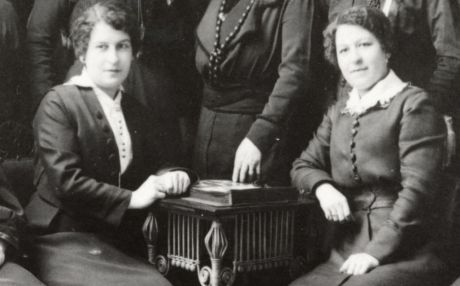Features
You are here
Women’s history: Franco-Ontario’s “Hatpin Girls”

March 5, 2016
On February 22, Premier Kathleen Wynne issued a formal apology to the Franco-Ontarian community for a rule that virtually banned the use of French in elementary schools early last century. "Regulation 17 showed a disregard for Franco-Ontarian identity and equality, and on behalf of the government of Ontario I offer an apology," Wynne told the legislature.
The apology might ring hollow from a government that has not invested in an education system that can properly sustain the French language in Ontario today. But it has recalled an inspiring story of resistance led by Franco-Ontarian women, teachers and mothers.
In fact, 2016 is the 100th anniversary of the “Battle of the Hatpins,” a chapter of women’s history that should not be forgotten.
Regulation 17
Regulation 17 was passed by a Conservative government in 1912 to assimilate the francophone population of Ontario. It severely restricted the use of French by teachers in both Catholic and public schools across Ontario right up until 1927, despite the fact that Ontario is home to about 612,000 Francophones, the largest French-speaking population in Canada outside of Quebec. Many of this generation, especially in northern Ontario, were denied the right to learn to write or speak their own language.
Regulation 17 was implemented amidst a rise of British sentiment in the Ontario government in the lead-up to WWI, and was enforced by threats to school funding and to teachers' certifications if schools or individual teachers continued to allow French to be spoken. It forced many Francophone teachers to resort to hiding French textbooks when school inspectors would visit the classroom.
“Ecoles de la résistance”
There were some schools that openly defied the government, calling themselves "écoles de la résistance." There were large protests against the regulation, especially in the Ottawa area, leading to the founding of Francophone newspapers and organizations, many of which are still in place today.
At the heart of resistance was Guigues elementary school in Ottawa in 1915-1916, when two women who taught there made history.
In 1915, two sisters, Diane Desloges and Béatrice Desloges of Ottawa, both teachers at the Guigues elementary school, refused to implement the provisions of Regulation 17. They were both banned from entering the Guigues elementary school property. With the support of some parents and members of the community, they opened classes in a “free school” located in a church basement and later in a commercial building.
Provincial authorities withheld their salaries and revoked their teaching certificates but they refused to back down. Students left the Guigues elementary school en masse and the teachers hired to replace the Desloges sisters were soon alone in an empty building. It wasn’t long after that parents launched a popular movement of civil disobedience. A group of mothers stormed the Guigues school in what came to be known as the “Battle of the Hatpins.”
Battle and occupation
On January 4, 1916 a group of mothers armed with scissors and hatpins occupied the Guigues elementary school and began guarding the school’s entrance. The Desloges sisters defied an injunction ordering them to immediately leave the school grounds or face arrest and imprisonment. They were protected by the mothers, who became known as the “school guardians,” and together this alliance of teachers and mothers staged a long day-and-night siege of this most famous “école de la résistance.”
At the end of January 1916, French students in Ottawa took part in a series of protests and sent a delegation to City Hall to demand that the salaries owed to their teachers be paid. As the protests continued, the “guardians of the school” maintained their vigil in the schools on strike until June. In order to thwart any attempt by the provincial authorities to expel the teaching staff, groups of women, again mostly mothers, remained on guard in front of the school armed with their hatpins.
Finally, with the beginning of the school year in the fall of 1916, the schools were reopened and the teachers were paid their salaries in arrears. The crisis came to an end in 1921 and bilingual schools in the province were officially recognized in 1927. It is truly one of the best examples of a grassroots strategy for resistance in local Ontario history.
And it was led by women. The two central heroines were not forgotten by the Francophone community of Ottawa, who in 1997 named a high school in a French-speaking suburb of Ottawa “Béatrice-Desloges.” But equally worthy of remembrance are the “hatpin girls” who defended them, the mothers and “guardians” of resistance to assimilation.
Apology and resistance
A hundred years later, in making her apology for Regulation 17, Kathleen Wynne dismissed the idea of compensation or reparations: she claimed the province is already making "concrete gestures" by providing French services and schools, and argued there is even a “debate” about creating a French university in Ontario.
But to make gestures concrete there will have to be a fight for massive reinvestment in education funding for all, and to sustain the Francophone presence in Ontario. For that, we can all take a page from the history of the Desloges sisters and the hatpin girls.
Section:










